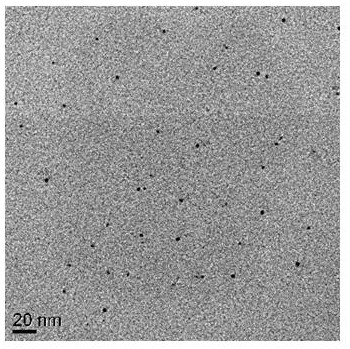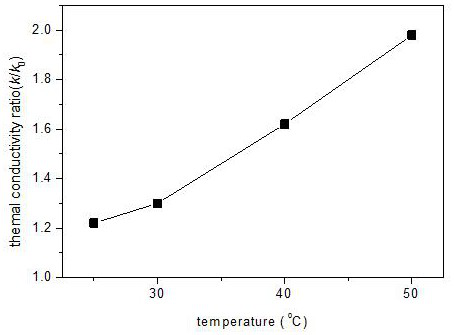A preparation method of amphiphilic hyperbranched molecular modified nanofluid
An amphiphilic hyperbranched, nanofluid technology, applied in the field of heat transfer, can solve problems such as the difficulty of ensuring the stability of nanofluids and the influence of the heat transfer capacity of nanofluids, and achieve the increase of heat transfer specific surface, prolong life, and step simple effect
- Summary
- Abstract
- Description
- Claims
- Application Information
AI Technical Summary
Problems solved by technology
Method used
Image
Examples
Embodiment 1
[0035] A preparation method of amphiphilic hyperbranched molecule modified nanofluid is as follows:
[0036] (1) Under a nitrogen atmosphere, dissolve 5 g of HPG in 20 mL of dimethyl sulfoxide, add 50 g of methacrylic acid dropwise, and stir vigorously for 5 h. After the reaction, pour it into 400 mL of ether and stir for half an hour to obtain light Yellow to brown viscous liquid sinks to the lower layer, the upper layer ether is discarded, and the intermediate product is obtained by rotary evaporation;
[0037] (2) Dissolve 1 g of the intermediate product obtained in step (1) in chloroform, add 5 times the mass of octadecyl mercaptan and 0.05 g of benzophenone, and react with ultraviolet photocatalysis for 1-3 h to obtain the crude product. Dialyze in 400 mL of chloroform for 2 days, and vacuum-dry to obtain amphiphilic HPG-C18;
[0038] (3) Add 10 mL of toluene and 0.2 g of amphiphilic HPG-C18 to a 50 mL flask, add 0.15 g of silver nitrate, stir magnetically at 25°C until ...
Embodiment 2
[0042] A preparation method of amphiphilic hyperbranched molecule modified nanofluid is as follows:
[0043] (1) Add 10 mL of toluene and 0.2 g of HPG-C18 obtained in Example 1 to a 50 mL flask, add 0.2 g of chloroauric acid, stir magnetically at 25°C until completely dissolved, and add 0.2 g of sodium citrate under a nitrogen atmosphere , reacted for 4 h. The reaction solution was rotary evaporated to remove toluene, dialyzed in chloroform for two days, and dried in vacuum for 24 hours to obtain amphiphilic hyperbranched molecular modified nanoparticles;
[0044] (2) Weigh amphiphilic hyperbranched molecule-modified nanoparticles and add them into decahydronaphthalene for ultrasonic dispersion for 1 h to obtain amphiphilic hyperbranched molecule-modified nanofluids with a nanoparticle content of 0.01%~0.3%. The silver nanofluid can be Stable for more than 1 month, the thermal conductivity at 50 ° C is 5% to 93% higher than that of the base fluid.
Embodiment 3
[0046] A preparation method of amphiphilic hyperbranched molecule modified nanofluid is as follows:
[0047] (1) Add 10 mL of toluene and 0.2 g of HPG-C18 obtained in Example 1 to a 50 mL flask, add 0.2 g of potassium chloropalladate, stir magnetically at 25°C until completely dissolved, and add 0.2 g of boron under a nitrogen atmosphere Sodium hydride, react for 4 h. The reaction solution was rotary evaporated to remove toluene, dialyzed in chloroform for two days, and dried in vacuum for 24 hours to obtain amphiphilic hyperbranched molecular modified nanoparticles;
[0048] (2) Weigh amphiphilic hyperbranched molecule-modified nanoparticles and add them into decahydronaphthalene for ultrasonic dispersion for 1 h to obtain amphiphilic hyperbranched molecule-modified nanofluids with a nanoparticle content of 0.01%~0.5%. The silver nanofluid can be Stable for more than 1 month, the thermal conductivity at 50°C is 10%~180% higher than that of the base fluid
PUM
| Property | Measurement | Unit |
|---|---|---|
| particle diameter | aaaaa | aaaaa |
Abstract
Description
Claims
Application Information
 Login to View More
Login to View More - R&D
- Intellectual Property
- Life Sciences
- Materials
- Tech Scout
- Unparalleled Data Quality
- Higher Quality Content
- 60% Fewer Hallucinations
Browse by: Latest US Patents, China's latest patents, Technical Efficacy Thesaurus, Application Domain, Technology Topic, Popular Technical Reports.
© 2025 PatSnap. All rights reserved.Legal|Privacy policy|Modern Slavery Act Transparency Statement|Sitemap|About US| Contact US: help@patsnap.com



